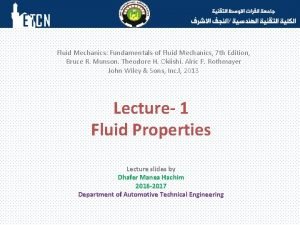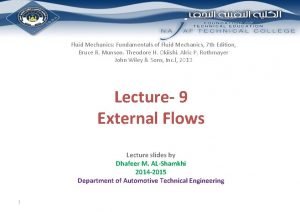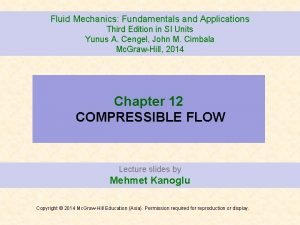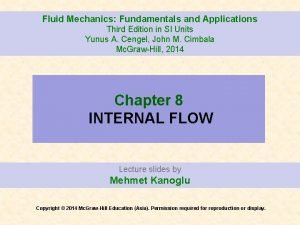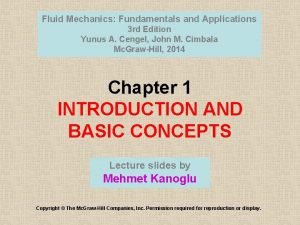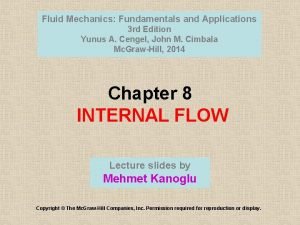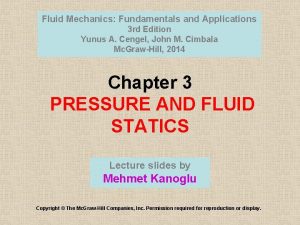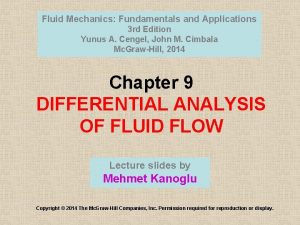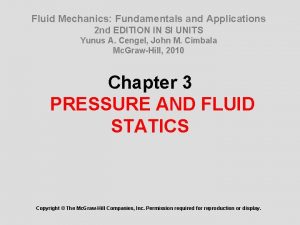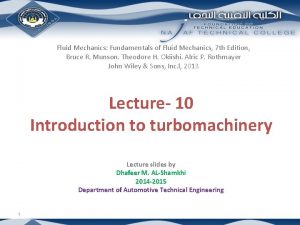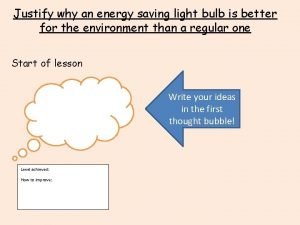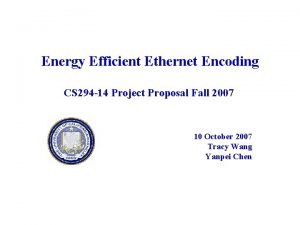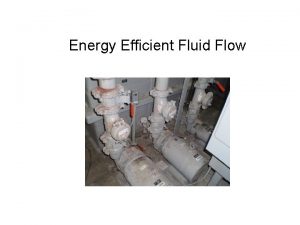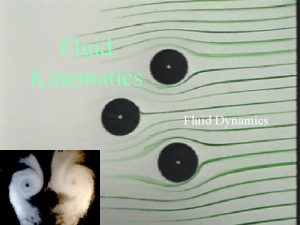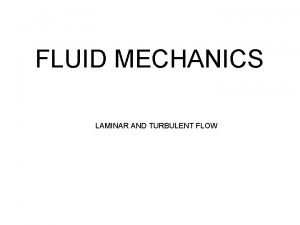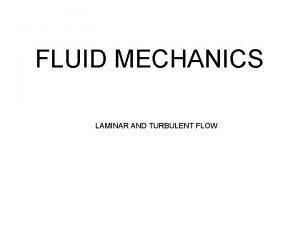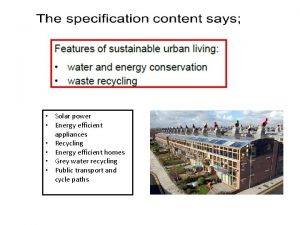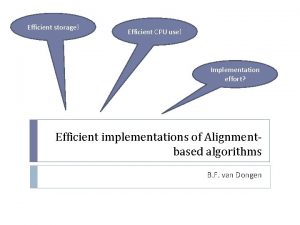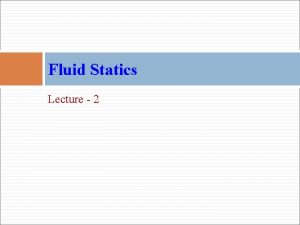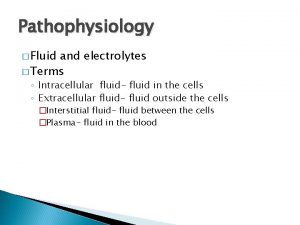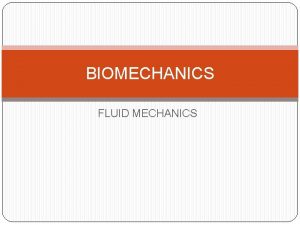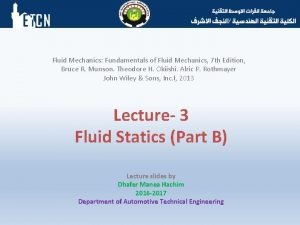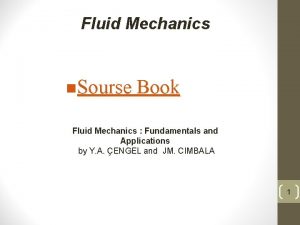Energy Efficient Fluid Flow Fluid Flow System Fundamentals





![Pumping System Savings Opportunities Welec = V DPtotal / [Effpumpx Effdrivex Effmotor ] • Pumping System Savings Opportunities Welec = V DPtotal / [Effpumpx Effdrivex Effmotor ] •](https://slidetodoc.com/presentation_image_h2/9002f01303caeaf950881290b6d11b6b/image-6.jpg)




























- Slides: 34

Energy Efficient Fluid Flow

Fluid Flow System Fundamentals Wmotor = Wfluid / (Effmotor x Effdrive x Effpump)

Look For “Inside” Opportunities to Max Savings • Efficiency losses in distribution and primary energy conversion systems multiply “inside” savings • Example: – Welec= Wfluid / [Effpumpx Effdrivex Effmotor ] – Welec= 1 k. Wh / [. 70 x. 92 x. 90 ] = 1. 7 k. Wh

Fluid Flow System Fundamentals Wfluid = V DPtotal

Fluid Flow System Fundamentals Wfluid = V DPtotal = V (k V 2) = k V 3 Wfriction = V DPfriction = k / D 5
![Pumping System Savings Opportunities Welec V DPtotal Effpumpx Effdrivex Effmotor Pumping System Savings Opportunities Welec = V DPtotal / [Effpumpx Effdrivex Effmotor ] •](https://slidetodoc.com/presentation_image_h2/9002f01303caeaf950881290b6d11b6b/image-6.jpg)
Pumping System Savings Opportunities Welec = V DPtotal / [Effpumpx Effdrivex Effmotor ] • Reduce volume flow rate • Reduce required pump head DPstatic DPvelocity DPelevation DPheadloss • Increase pump, drive, motor efficiency

Fluid Flow System Saving Opportunities • Reduce Required Pump/Fan DP • Employ Energy Efficient Flow Control • Improve Efficiency of Pumps/Fans

Reduce Pump/Fan DP

Increase Reservoir Level to Reduce Elevation Head

Minimize Pipe Friction: Use Bigger Pipes/Ducts § Use large diameter pipes: § DP headloss ~ k / D 5 § Doubling pipe diameter reduces friction by 97%

Minimize Pipe Friction Use Smooth Pipes/Ducts §Use smooth plastic pipes: § fsteel = 0. 021 fplastic = 0. 018 § Pumping savings from plastic pipe (0. 021 – 0. 018) / 0. 018 = 17%

Use Gradual Elbows

Use Gradual Elbows

Employ Energy Efficient Flow Control

Inefficient Flow Control By-pass loop By-pass damper Outlet valve/damper Inlet vanes (No savings) (Small savings) (Moderate savings)

Efficient Flow Control Trim impellor for constant-volume pumps Slow fan for constant-volume fans VFD for variable-volume pumps or fans

Inefficient and Efficient Flow Control

Cooling Towers

Cooling Loop Pumps

Worlds Largest Bypass Pipe

For Constant Speed Pump Applications: Trim Pump Impellor • Look for discharge valve at < 100% open • More energy-efficient to downsize the pump by trimming impellor blades than throttle flow

Trim Impellor and Open Throttling Valve

For Constant Speed Fan Applications: Slow Fan Speed by Changing Pulley Diameter • Look for discharge damper at < 100% open • More energy-efficient to slow fan throttle flow

For Variable Flow Applications: Install VFD • W 2 = W 1 (V 2/V 1)3 • Reducing flow by 50% reduces pumping costs by 87%

Variable Speed Pumping on HVAC Chilled Water Loops Replace 3 -way Valve with 2 -way valve on AHU

VFDs on Vent Hoods

Need Controls for VFDs on Dust Collection

Use VFDs on Cooling Tower Fans

Pump Long, Pump Slow • Identify intermittent pumping applications • More energy to pump at high flow rate for short period than low flow rate longer Reason: Wfluid = V DP = k V 3 • Example: – Current: Two pumps in parallel for four hours – Recommended: One pump for six hours – Estimated Savings: $500 /yr

Optimize Efficiency of Pumps/Fans

Correct Fan Inlet/Exit Conditions No Yes

Refurbish Inefficient Pumps Pump not operated at peak efficiency in middle of operating range

Resize Miss-sized Pumps • Pump operating at off-design point M • Eff = 47% • Replace with properly sized pump • Estimated savings: $14, 000 /yr

Fluid Flow Summary • Reduce Required Pump/Fan Head – – Reduce excess elevation head Smoother pipes/ducts Larger diameters Gradual elbows • Employ Energy Efficient Flow Control – – Constant speed pumping: trim impellor blade Constant speed fans: Slow fan Variable flow: Install VFDs Pump slow, pump long • Improve Efficiency Pumps/Fans – Correct fan inlet/exit conditions – Refurbish inefficient pumps – Resize miss-sized pumps/fans
 Productively efficient vs allocatively efficient
Productively efficient vs allocatively efficient Productively efficient vs allocatively efficient
Productively efficient vs allocatively efficient Productively efficient vs allocatively efficient
Productively efficient vs allocatively efficient Allocative efficiency vs productive efficiency
Allocative efficiency vs productive efficiency Allocative efficiency vs productive efficiency
Allocative efficiency vs productive efficiency No slip condition
No slip condition Capillary force
Capillary force Momentum thickness turbulent boundary layer
Momentum thickness turbulent boundary layer Mach number in fluid mechanics
Mach number in fluid mechanics Fluid mechanics fundamentals and applications
Fluid mechanics fundamentals and applications Fluid mechanics fundamentals and applications
Fluid mechanics fundamentals and applications Laminar flow
Laminar flow Fluid mechanics fundamentals and applications
Fluid mechanics fundamentals and applications Viscous fluid example
Viscous fluid example Fluid mechanics fundamentals and applications
Fluid mechanics fundamentals and applications Pumps fluid mechanics
Pumps fluid mechanics Led light bulb sankey diagram
Led light bulb sankey diagram Building energy codes resource center
Building energy codes resource center Intel energy efficient ethernet
Intel energy efficient ethernet Energy-efficient embedded systems
Energy-efficient embedded systems Energy naturally flows from warmer matter to cooler matter
Energy naturally flows from warmer matter to cooler matter Oikos meaning
Oikos meaning Energy energy transfer and general energy analysis
Energy energy transfer and general energy analysis Energy energy transfer and general energy analysis
Energy energy transfer and general energy analysis Synovial membrane
Synovial membrane P1-p2
P1-p2 Fluid statics deals with
Fluid statics deals with Total body water
Total body water Bioimpedância
Bioimpedância Interstitial vs intracellular
Interstitial vs intracellular Timeline fluid mechanics
Timeline fluid mechanics Movement of body fluids
Movement of body fluids Fluid thrill volume
Fluid thrill volume Energy industry fundamentals
Energy industry fundamentals Grade 7 ns project term 3
Grade 7 ns project term 3






